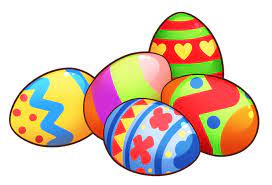 What a magnificent event to invite friends and neighbors. There will be a light meal, games, art activities, and a chance to get a picture with an Easter Bunny! Have you ever wondered what eggs have to do with Easter? Why do we dye and hunt for Easter eggs every year? What is the connection between Easter eggs and the crucifixion and resurrection of Jesus Christ? Many of us might think Easter eggs and Easter egg hunts are a commercialized form of the Easter celebration, but the roots are deeply embedded in the practices of early Christians in eastern cultures. There is religious significance behind the Easter traditions that we still practice today. Although eggs were a symbol of fertility and rebirth in pagan cultures, early Christians used Easter eggs to symbolize parts of the Easter story. Easter eggs represent the empty tomb from which Jesus resurrected. In early Orthodox churches, Easter eggs were blessed by the priests and given to members on the day before Easter known as Holy Saturday. During worship, Easter eggs are handed out to symbolize Jesus’ resurrection. The hard shell represents the sealed tomb, The cracking of the egg represents Jesus’ resurrection from the dead. While it might seem like a strange tradition to hand out Easter eggs in worship, early Christians abstained from eating eggs and meat during Lent. The fast was a form of sacrifice to prepare for Easter. Therefore, Easter was the first time Christians could eat eggs. Christians of Mesopotamia began the custom of dyeing Easter eggs. Originally, Christians dyed eggs red to represent the blood of Jesus Christ that was shed on the cross. Over time, this tradition spread throughout eastern Orthodox churches and eventually made its way to Catholic and Protestant churches in Europe. Early Christian missionaries dyed the eggs assorted colors to represent various aspects of the Easter story. They used yellow to represent the resurrection, blue to represent love, and red to represent the blood of Christ. Sometimes, the missionaries would paint biblical scenes on the eggs and hide them. The children would find the Easter eggs and tell the story associated with the paintings. Therefore, early Easter egg hunts helped children learn about the significance of Easter. One of the earliest Easter egg hunts that most resembles the modern Easter egg hunt can be traced to Martin Luther. During this time, men would hide eggs for women and children to find. The joy the women and children experienced as they found eggs mirrored the joy the women felt when they found Jesus’ tomb empty and realized He had risen. And then there is the Easter Bunny. Writings from the 17th century in Germany describe the “Oschter Haws” (Easter hare) for the first time. According to folklore, the Easter hare would lay colorful eggs in the nests (baskets) of well-behaved children. German immigrants brought this tradition of the Easter Bunny to the United States in the 18th century. We hope our Easter Egg Extravaganza will bring the same happiness and joy Jesus’ followers experienced when they heard the Good News of His resurrection.
1 Comment
Karen Glenn
3/20/2024 04:18:10 pm
Wonderful explanation of the significance of eggs during this Easter Season.
Reply
Leave a Reply. |
Archives
July 2024
Categories |